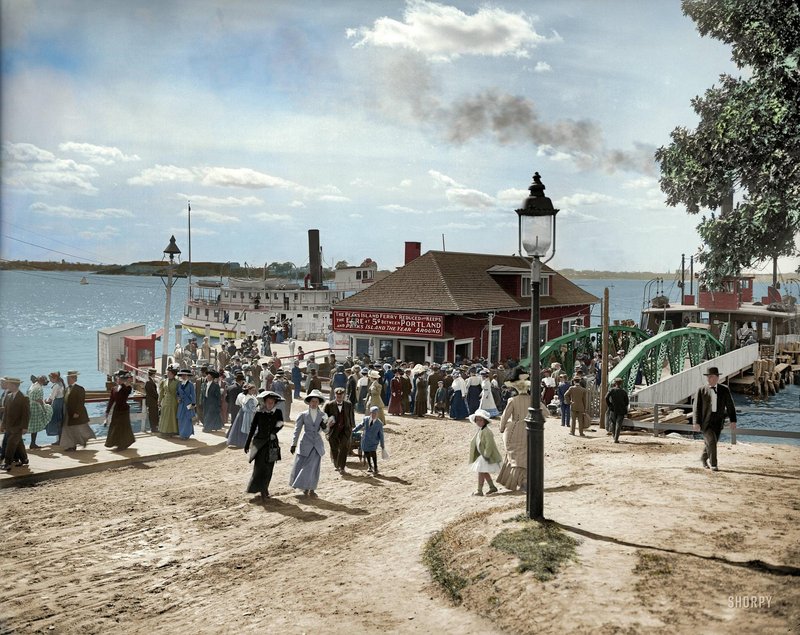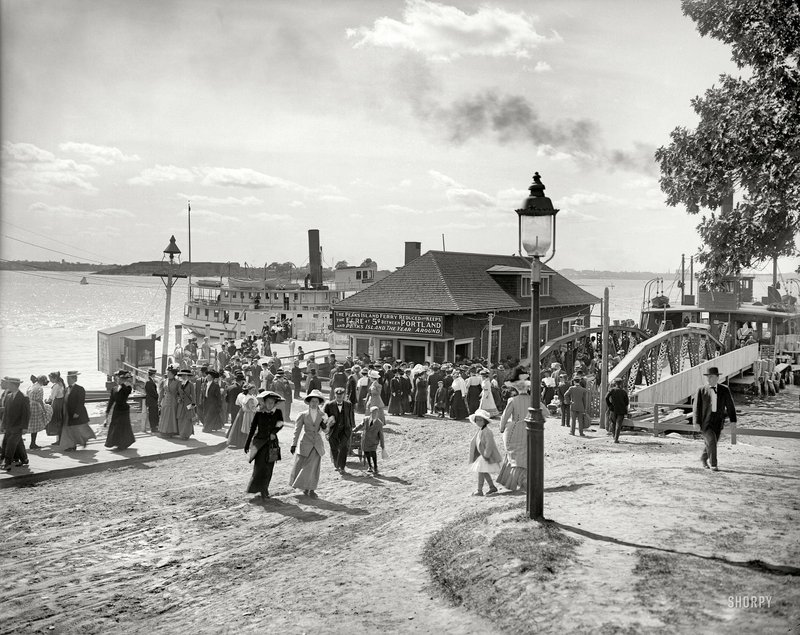Patty Allison has spent more than 10 hours at her computer adding color to the more than 1 million pixels of a 1910 photo of a ferry landing on Peaks Island. But she still seemed surprised to see the finished product.
“Oh!” Allison gasped as she opened the photo on her laptop. “I mean, look at that. Isn’t that just freakin’ amazing?”
Allison, a self-employed dog groomer, uses her spare time to digitally colorize photos of Portland scenes from more than a century ago, to help people connect with the city’s past. The 52-year-old’s eyes light up and she gestures energetically when she talks about her three-month-old venture.
“If it’s a great picture, I love to work on it. And when the color goes on, it’s a whole different ball game, the photo just comes alive,” Allison said.
Allison, who taught herself digital colorization after dabbling in photography and photo restoration, has so far completed about 30 photos, six of them taken in Portland or other parts of Maine. She said she began the project as a hobby and hoped to draw attention to Portland’s rich history but may soon be showing and selling her work through a local gallery.
The results of Allison’s color work are familiar Portland scenes that look like they could have been shot in 2013, except for the horse carriages, dirt roads and corseted pedestrians. The people in the photos are especially striking in color: The flesh tones that Allison overlays bring out their facial expressions and provide a reminder that modern denizens are not the first to travel Portland’s streets.
Allison starts by searching through old photos on Shorpy.com, a historical photos website that takes photos from the U.S. Library of Congress. Then she becomes a color detective, taking one to five hours to research materials and hues used in everything from bustle skirts to cobblestone curbs.
“I try to go to the place where the pic was taken either in real life or with Google (Street View),” Allison said. “I even try to find historical paint colors.”
With the high-definition photo open in Adobe Photoshop on her computer, she uses tools like the paintbrush and paint bucket to give each pixel some semitransparent color. Although she’s working on old photos, Allison’s process would be impossible without technology, since she uses everything from YouTube video tutorials to learn new techniques, to streaming television shows on Netflix for background sound as she does the painstaking work.
Each photo involves making judgment calls about color, and Allison said one of her goals is to make the scene in the photo feel familiar to people so they can better connect to it.
“I do research on every single storefront and everything,” Allison said. “If I can’t get it to the exact same brown, I try to get it pretty close, so that it jumps out at people and they can say: ‘Oh! I know that place.”‘
When she finishes a photo, she will usually post it to the social website Reddit to share her work and get feedback.
“The beauty of Reddit is, the demographic is like 14- to 18-year-old boys, and they can be hypercritical, but I love it,” said Allison, adding later that Reddit’s users are probably more male users in their 20s or 30s. “I take it as constructive criticism.”
When Allison posted her colorized version of 1907 State St., her online critics pointed out that the scene was too dull for a sunny day.
“The critics started saying, ‘You need some yellow in those trees,’ and when that was done, it looks great. It’s simple but not something you think about if you don’t know, that the sun shining makes things yellow,” Allison said.
But for other elements of the photos, Allison has to rely on her imagination and how she wants the finished photo to look, balancing her love for art and history.
This was the case when someone theorized that the grass in the State Street photo looked too flawless, and therefore wasn’t accurate.
“I said this grass is shaded by these giant elm trees and I think it would have been lush,” Allison said. “But to me it’s like that movie ‘Pleasantville,’ where it’s not perfect, but it’s how I would like to see it.’
In that 1998 movie, a pair of siblings are transported to an idyllic 1950s black-and-white world. Slowly they introduce color and teach the characters to break some rules.
Kevin Ready, 37, browses content on Reddit and said he finds Allison’s photos interesting, even though he was a bit skeptical at first.
“Personally, they surprised me because I have a kind of a bias against colorization and things of that nature, but these photos didn’t look gaudy or anything. They were very well done,” said Ready, of Portland.
Ready said he usually agrees with opponents of colorizing old black-and-white films, or adding sound to silent films.
“People say that (color or sound) took away from the original art, and that sort of does inform my ideas a bit,” Ready said.
But Ready said he appreciated the color work of Allison’s photos and examined those taken of places he goes to regularly, such as the ferry landing photo.
Allison said that photo is one of her favorites, too. After working out the hues on the individual subjects’ faces and clothing, she said she started to imagine their personal histories. She focused in on a group of women on their way off the ferry on the left of the photo.
“This part is my favorite,” Allison said as she pointed to two women in the photo walking and holding hands.
“And this woman is just like, ‘I’ve got so much to do at the office, just get out of my way, ugh,”‘ Allison said as she indicated an impatient-looking woman behind the two holding hands.
“And then you know, you’ve got me over here,” Allison laughs as she points out a woman in period clothes in the photo that bears a striking resemblance to the artist, sans tattoos.
The Auburn resident is not the first to look at the photos and try to decide what colors make up Portland. The photos that Allison uses were shot between 1890 and 1920 by unattributed photographers with the Detroit Photographic Co., later renamed the Detroit Publishing Co.
The company’s large, detailed black-and-white prints were then made into collectible, color postcards.
State Historian Earle G. Shettleworth Jr. said that while it’s unclear where the Detroit company did its colorizing, other smaller-scale companies usually sent them to Germany with notations made by the photographer on the color of the real-life objects. There, the photos went through a five- to 14-color process, each separate color requiring a different lithographic stone.
“The fascinating point is that whether it’s the colorized version made by the Detroit company, or her colorized version a little more than a century later, neither is exactly correct,” Shettleworth said. “In both cases, it’s someone’s interpretation of what the colors should be.”
Shettleworth said Allison’s work was the first time digitally colorizing old photos was brought to his attention. He doesn’t think it interferes with history as long as people are aware the photo is an interpretation and may not be true to life.
Allison plans to print and frame some of her photos, and they will be available at the Full Circle Artisan’s Gallery & Bead Emporium in Cornish once she raises the money to get the works mounted and framed. She is currently colorizing some family photos on commission to raise funds. A colorized photo that is printed, mounted, framed and signed would sell for $50 to $75, she said.
Allison said she is mostly excited that her work is drawing attention to the city’s history.
“These photos are 100-plus years old and they’ve been on Shorpy forever. No one’s seen them,” she said. “Now there’s a little excitement about our little city and I love it.”
Karen Antonacci can be contacted at 791-6377 or at:
kantonacci@mainetoday.com
Send questions/comments to the editors.




Success. Please wait for the page to reload. If the page does not reload within 5 seconds, please refresh the page.
Enter your email and password to access comments.
Hi, to comment on stories you must . This profile is in addition to your subscription and website login.
Already have a commenting profile? .
Invalid username/password.
Please check your email to confirm and complete your registration.
Only subscribers are eligible to post comments. Please subscribe or login first for digital access. Here’s why.
Use the form below to reset your password. When you've submitted your account email, we will send an email with a reset code.